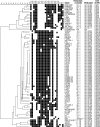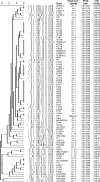Rapid determination of Escherichia coli O157:H7 lineage types and molecular subtypes by using comparative genomic fingerprinting
- PMID: 18791027
- PMCID: PMC2576696
- DOI: 10.1128/AEM.00985-08
Rapid determination of Escherichia coli O157:H7 lineage types and molecular subtypes by using comparative genomic fingerprinting
Abstract
In this study, variably absent or present (VAP) regions discovered through comparative genomics experiments were targeted for the development of a rapid, PCR-based method to subtype and fingerprint Escherichia coli O157:H7. Forty-four VAP loci were analyzed for discriminatory power among 79 E. coli O157:H7 strains of 13 phage types (PT). Twenty-three loci were found to maximize resolution among strains, generating 54 separate fingerprints, each of which contained strains of unique PT. Strains from the three previously identified major E. coli O157:H7 lineages, LSPA6-LI, LSPA6-LI/II, and LSPA6-LII, formed distinct branches on a dendrogram obtained by hierarchical clustering of comparative genomic fingerprinting (CGF) data. By contrast, pulsed-field gel electrophoresis (PFGE) typing generated 52 XbaI digestion profiles that were not unique to PT and did not cluster according to O157:H7 lineage. Our analysis identified a subpopulation comprised of 25 strains from a closed herd of cattle, all of which were of PT87 and formed a cluster distinct from all other E. coli O157:H7 strains examined. CGF found five related but unique fingerprints among the highly clonal herd strains, with two dominant subtypes characterized by a shift from the presence of locus fprn33 to its absence. CGF had equal resolution to PFGE typing but with greater specificity, generating fingerprints that were unique among phenotypically related E. coli O157:H7 lineages and PT. As a comparative genomics typing method that is amenable for use in high-throughput platforms, CGF may be a valuable tool in outbreak investigations and strain characterization.
Figures


Similar articles
-
Escherichia coli O157:H7 strains that persist in feedlot cattle are genetically related and demonstrate an enhanced ability to adhere to intestinal epithelial cells.Appl Environ Microbiol. 2009 Sep;75(18):5927-37. doi: 10.1128/AEM.00972-09. Epub 2009 Jul 17. Appl Environ Microbiol. 2009. PMID: 19617387 Free PMC article.
-
In silico genomic analyses reveal three distinct lineages of Escherichia coli O157:H7, one of which is associated with hyper-virulence.BMC Genomics. 2009 Jun 29;10:287. doi: 10.1186/1471-2164-10-287. BMC Genomics. 2009. PMID: 19563677 Free PMC article.
-
Characterisation of Shiga toxin-producing Escherichia coli O157 strains isolated from humans in Argentina, Australia and New Zealand.BMC Microbiol. 2008 Mar 17;8:46. doi: 10.1186/1471-2180-8-46. BMC Microbiol. 2008. PMID: 18366637 Free PMC article.
-
Genomic typing of Escherichia coli O157:H7 by semi-automated fluorescent AFLP analysis.Microbes Infect. 2000 Feb;2(2):107-13. doi: 10.1016/s1286-4579(00)00278-1. Microbes Infect. 2000. PMID: 10742682
-
Methods and tools for comparative genomics of foodborne pathogens.Foodborne Pathog Dis. 2008 Aug;5(4):487-97. doi: 10.1089/fpd.2008.0117. Foodborne Pathog Dis. 2008. PMID: 18713064 Free PMC article. Review.
Cited by
-
Genotypic Features of Clinical and Bovine Escherichia coli O157 Strains Isolated in Countries with Different Associated-Disease Incidences.Microorganisms. 2018 Apr 27;6(2):36. doi: 10.3390/microorganisms6020036. Microorganisms. 2018. PMID: 29702577 Free PMC article. Review.
-
Multilocus genotypic characterization of Escherichia coli O157:H7 recovered from food sources.Epidemiol Infect. 2015 Aug;143(11):2367-72. doi: 10.1017/S0950268814003197. Epub 2014 Nov 27. Epidemiol Infect. 2015. PMID: 25428257 Free PMC article.
-
Pan-genome sequence analysis using Panseq: an online tool for the rapid analysis of core and accessory genomic regions.BMC Bioinformatics. 2010 Sep 15;11:461. doi: 10.1186/1471-2105-11-461. BMC Bioinformatics. 2010. PMID: 20843356 Free PMC article.
-
Whole genome shotgun sequencing revealed highly polymorphic genome regions and genes in Escherichia coli O157:H7 isolates collected from a single feedlot.PLoS One. 2018 Aug 28;13(8):e0202775. doi: 10.1371/journal.pone.0202775. eCollection 2018. PLoS One. 2018. PMID: 30153286 Free PMC article.
-
Development and validation of a comparative genomic fingerprinting method for high-resolution genotyping of Campylobacter jejuni.J Clin Microbiol. 2012 Mar;50(3):788-97. doi: 10.1128/JCM.00669-11. Epub 2011 Dec 14. J Clin Microbiol. 2012. PMID: 22170908 Free PMC article.
References
-
- Ahmed, R., C. Bopp, A. Borczyk, and S. Kasatiya. 1987. Phage-typing scheme for Escherichia coli O157:H7. J. Infect. Dis. 155:806-809. - PubMed
-
- Aires-de-Sousa, M., K. Boye, H. de Lencastre, A. Deplano, M. C. Enright, J. Etienne, A. Friedrich, D. Harmsen, A. Holmes, X. W. Huijsdens, A. M. Kearns, A. Mellmann, H. Meugnier, J. K. Rasheed, E. Spalburg, B. Strommenger, M. J. Struelens, F. C. Tenover, J. Thomas, U. Vogel, H. Westh, J. Xu, and W. Witte. 2006. High interlaboratory reproducibility of DNA sequence-based typing of bacteria in a multicenter study. J. Clin. Microbiol. 44:619-621. - PMC - PubMed
-
- Avery, S. M., E. Liebana, C. Reid, M. J. Woodward, and S. Buncic. 2002. Combined use of two genetic fingerprinting methods, pulsed-field gel electrophoresis and ribotyping, for characterization of Escherichia coli O157 isolates from food animals, retail meats, and cases of human disease. J. Clin. Microbiol. 40:2806-2812. - PMC - PubMed
-
- Barrett, T. J., H. Lior, J. H. Green, R. Khakhria, J. G. Wells, B. P. Bell, K. D. Greene, J. Lewis, and P. M. Griffin. 1994. Laboratory investigation of a multistate food-borne outbreak of Escherichia coli O157:H7 by using pulsed-field gel electrophoresis and phage typing. J. Clin. Microbiol. 32:3013-3017. - PMC - PubMed
-
- Beutin, L., S. Kaulfuss, S. Herold, E. Oswald, and H. Schmidt. 2005. Genetic analysis of enteropathogenic and enterohemorrhagic Escherichia coli serogroup O103 strains by molecular typing of virulence and housekeeping genes and pulsed-field gel electrophoresis. J. Clin. Microbiol. 43:1552-1563. - PMC - PubMed
Publication types
MeSH terms
Substances
LinkOut - more resources
Full Text Sources
Research Materials

